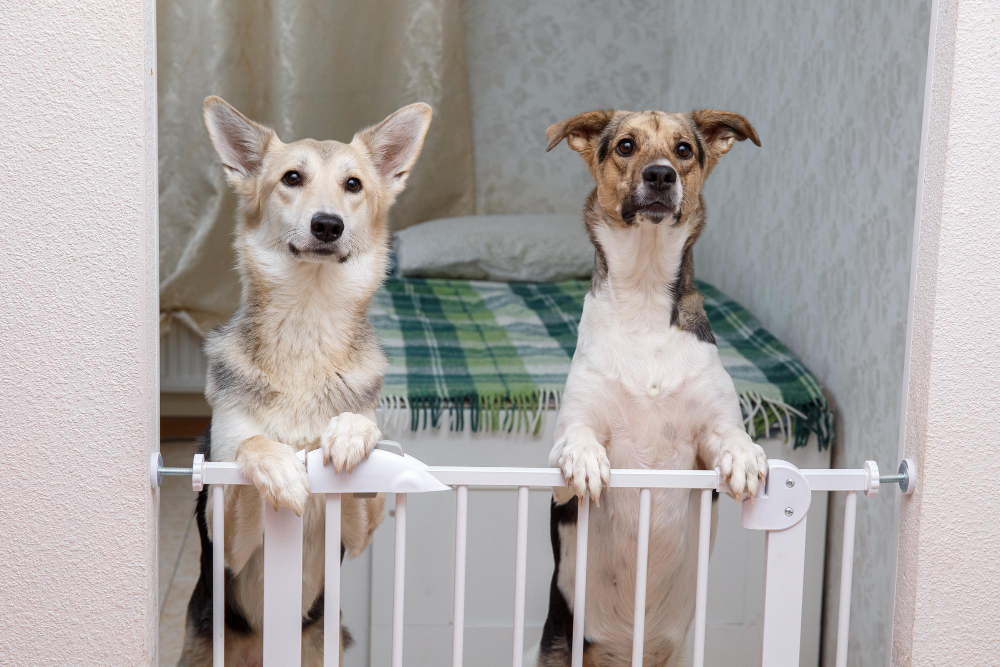Pets and children bring joy and love into our homes, but ensuring their safety is a top priority for any responsible pet owner or parent. With the myriad of gate options available, making the right choice can be overwhelming. In this article, we will discuss the key differences between dog gates and baby gates, and explore various gate options, including high stair gates for dogs, free-standing dog stair gates, cardinal gates step over pet gates, and pet safety gate dog gates with door.
Can I Use a Dog Gate as a Baby Gate?
It’s not uncommon for pet owners to wonder if they can use a dog gate as a baby gate. While both gates serve the purpose of creating a barrier, there are some crucial differences that need to be considered. Baby gates are designed specifically to meet safety standards for young children, whereas dog gates may not adhere to these standards.
For example, baby gates often have smaller gaps between bars to prevent little fingers from getting stuck, and they also include a child-proof locking mechanism. Using a dog gate as a baby gate may pose risks, such as a child climbing over or getting stuck. It’s best to choose a gate designed specifically for your intended purpose to ensure the safety of both your child and your pet.
High Stair Gates for Dogs
High-stair gates for dogs are designed to prevent your dog from accessing potentially dangerous areas, such as stairs or rooms with hazards. These gates are typically taller than standard dog gates, making them more difficult for larger or more agile dogs to jump over.
One popular option is the cardinal gates step-over pet gate, which is designed with a sturdy construction and adjustable width to accommodate various staircases and doorways. When selecting a high stair gate for your dog, consider factors such as the gate’s height, durability, and ease of installation.
Free-Standing Dog Stair Gates
A free-standing dog stair gate offers a versatile solution for pet owners looking to create a barrier without attaching it to walls or door frames. These gates can be easily moved and adjusted to fit various spaces in your home.
The question of safety is often raised when considering freestanding dog gates. While these gates can be secure and stable, it’s crucial to choose a high-quality product with a sturdy base and non-slip feet to prevent tipping. Additionally, always ensure that the gate is tall enough and properly positioned to prevent your dog from jumping over or pushing it aside.
Pet Safety Gate Dog Gate with Door
A pet safety gate dog gate with a door combines the functionality of a barrier with the convenience of a built-in door, allowing you to pass through the gate without the need to remove or step over it. These gates are particularly useful in high-traffic areas where frequent access is required.
When selecting a pet safety gate dog gate with door, consider features such as the door’s locking mechanism, the gate’s overall durability, and its compatibility with your home’s doorways or staircases. Some top options on the market provide a blend of safety, functionality, and stylish design.
What Can I Use Instead of a Dog Gate?
Alternative solutions to dog gates exist for pet owners who may require a different approach to pet containment. Some of these options include playpens, exercise pens, and pet barriers. Each alternative has its benefits and drawbacks, so it’s essential to evaluate your pet’s needs and your home’s layout before making a decision.
Playpens and exercise pens provide a confined space for your dog to play and move around without the risk of accessing off-limits areas. These options are great for puppies or dogs that need a secure space while their owner is away or occupied. However, they may not be suitable for larger dogs or dogs that require more freedom to roam.
Pet barriers, on the other hand, are designed to block off specific areas without the need for a full gate. They can be a great option for wider openings or irregular spaces where a traditional dog gate may not fit. Keep in mind that pet barriers may not be as secure as a gate, and some dogs may be able to bypass them with ease.
How Tall of a Gate Should I Get for My Dog?
Determining the appropriate height for your dog gate involves considering factors such as your dog’s breed, size, and jumping ability. As a general guideline, the gate should be tall enough to prevent your dog from easily jumping over it.
To choose the right gate height, measure your dog’s shoulder height and add several inches to account for their jumping capability. Additionally, measure the width of the opening where the gate will be installed to ensure a proper fit. Remember that some dogs may still attempt to climb or jump over the gate, so monitoring your pet’s behavior around the gate is crucial to their safety.
Conclusion
In conclusion, choosing the right gate or alternative solution for your pet’s safety and your peace of mind is essential. By understanding the key differences between dog gates and baby gates, as well as exploring various gate options such as high stair gates for dogs, free standing dog stair gate, cardinal gates step over pet gate, and pet safety gate dog gate with door, you will be better equipped to make an informed decision.
Remember to carefully consider factors such as the gate’s height, durability, and compatibility with your home’s layout before making a purchase. By selecting the best solution for your specific needs, you can ensure a safe and secure environment for both your pet and your family.

